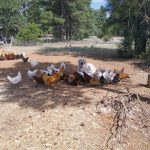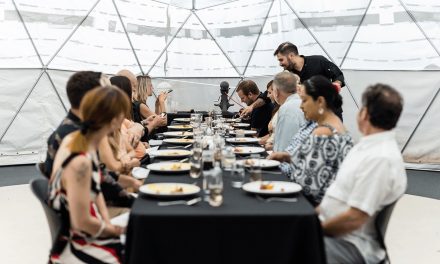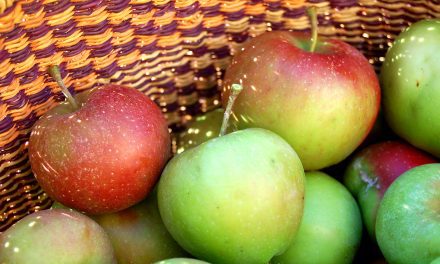
Left to right: Anita Ashok Adalja, Mallika Singh, Ash Abeyta.
Ashokra Farm is named for Anita Adalja’s father, whose name is Ashok, and for okra, a mainstay of Indian cuisine and the farm’s first crop. Ashokra now grows many dozens of types of crops on two and a half leased acres split between four fields in Albuquerque’s North Valley. Although the farm is currently co-owned by Anita and Ash, the farmers have a dream of collective ownership, a model integrating shared responsibility, shared management, and shared profits.

People
Anita Ashok Adalja: I was practicing as a social worker in Crown Heights, Brooklyn, and I started a rooftop garden with a coworker. It changed my way of thinking and what I wanted to do with my life.
Seasons farming: 12
Side hustles: Food safety trainings for farmers, Good Agricultural Practices auditor
Mallika Singh: I’ve grown up learning a lot about food and herbs and medicine, but I started getting interested in farming a couple years ago. Not just growing food but also having a closer relationship to the land and the food system as a whole.
Seasons farming: 2
Side hustles: Catering; cooking; cocreator of OOZE, a poetry event
Ash Abeyta: I’m from northern New Mexico. I moved here for college but fell in love with farming.
Seasons farming: 11
Side hustles: Contract reviewer for National Young Farmers Coalition, DoorDash driver
Note: Antonia Ruiz was traveling when we gathered in December. Her grandmother was a farmer in Colombia and her father still farms there.
Seasons farming: 3

WHAT IT MEANS TO BE A FARMER
Ash: Every season, we have to deal with some new problem, whether it be early wind, or a bug we’ve never seen, or fires—there’s always something new. I think [being a farmer means] being resilient and problem solving along the way and dealing with things as they come.
Anita: For so long we have heralded farmers as heroes doing God’s work. . . . It’s time to understand that farmers are business owners. And also need to be held accountable. Farming is amazing work, but also—and this is something going from worker to owner that I think about all the time—it’s a choice. What’s that Spider-Man quote? “With great power comes great responsibility.” We have a responsibility to treat people well on a farm.

GOALS
Anita: Right now we’re growing food and selling it. We want to do more. We have ideas of having educational workshops and access to the produce. We don’t want productivity or success to be measured by how much food we can sell. It’s about the community we’re building and working with and increasing food access. . . . If you look at what we’ve done this year, it feels really good. You can’t measure it by money. But if you look at it as what we’ve built together.
Mallika: How much we’ve laughed.
Anita: That we’ve had access to a bathroom. Honestly, building this composting toilet and ensuring that at any field we’re working at, we have access to a bathroom. That might seem like a low bar but in the twelve years I’ve farmed, this is a privilege. To have a bathroom with a door, and dignity.
CHALLENGES
Anita: Land access has been a big issue for us. It’s not ideal for us to have two and a half acres spread across four parcels. The logistics alone are really challenging. I can’t tell you how many people Ash and I had to contact and interview with to get those four parcels of land, and what it took in terms of showing our résumé, giving crop plans, business plans, and that, I can definitely say, I think is based on who we are, the identities that we hold.

IF RESOURCES WERE NO ISSUE, WHAT ARE THE FIRST THREE THINGS YOU’D DO?
Mallika: Pay all of us.
Ash: Build structures so we’re not out in the cold or heat. And season extension.
Anita: I would love all our properties in one, one land. Shelter—having space to build a kitchen where we can all meet protected from the elements. A ninety-nine-year lease.
Ash: It’s a big gamble for us to invest in something we don’t own because one day they could change their mind and decide that they don’t like how the farm looks in their backyard. We invested thousands of dollars in this compost pile, for example, and if that gets taken away, what do we do? Or the years that we’ve built in soil.
CLIMATE
Anita: We lost our whole okra crop in the Memorial Day hailstorm in 2021. It set us back six weeks because we had to reseed. Because of that, we started transplanting okra.
Ash: This year we had three weeks of 99-degree temperatures. So, starting everything with transplants.
Anita: The wind is huge. Making sure everything is very secure.
Mallika: We’ve been in extreme drought for a decade now. Realistically, we are gonna continue to be in drought, and probably in drier and harsher conditions. . . . I think we also have to change what we’re willing to do, what we’re willing to eat, what we’re willing to grow. Lettuce doesn’t really grow here easily.
Anita: We grew thirteen varieties of okra this year. We have an added-value product of dehydrated okra chips through Three Sisters Kitchen. That makes sense for us. We have a relationship with okra. It grows really well here. It is a climate change crop for sure. And it’s also, what personally do we want to grow? Because farming is such hard work that we have to have joy in it too.
FAVORITE CROPS
Anita: Dry beans was a really awesome thing to grow, and winter squash was a great crop for us. Carrots.
Ash: I like radishes in the spring—they grow really fast, after winter they look really nice. They’re just really pretty after a hard winter, grays and browns.
Mallika: I was super into green garlic this spring. Using the leaves and everything. That’s something cool about farming too, you see every iteration of a certain plant.

ON NEW MEXICO AGRICULTURE
Anita: It’s not enough to say that we’re all small farmers. . . . We see the New Mexico Grown program and procurement going to senior centers, schools, early education, sourcing from local farms. And that’s good. On the surface, that’s amazing. Look a little deeper—we need to look at equity too. We have thirty-acre farms competing with two-acre farms. There needs to be an appraisal of how we can make this a more equitable system. It’s not all about supporting small farmers, because not all small farmers are the same.
VALUES
Ash: Anita and I really wanted to build something where everyone felt valued and welcomed. Speaking personally, at farms I feel like I’m just another set of hands or just a body. We want everyone who steps on our farm to feel like they matter.
Anita: Another value is making sure the space is accessible for you to show up as your authentic self. That means race, class, gender, but also ability. I worked on a farm where the owner would tell people to lose weight to work faster. We’re trying to create a space where farming is for everyone. For every ability level. And also to move away from that blood, sweat, and tears mentality. This is about sustainability for your physical body too. I feel like I’ve given some of my strongest years to building other people’s farms, and you can’t get that back. We really want a place where people want to stay and can sustain.
Mallika: Productivity, success, efficiency—some of the values we’ve talked about mean measuring those things outside of speed or money. A value for me is having fun. We’re also here to learn and be able to ask questions and make jokes. Because it is important work. This is the kind of work I want to feel connected to.

“I would like to see this myth of rugged individualism, that a farm is one person, to just go away. Farms are multiple people. There’s often a totally invisible workforce that we never see, that aren’t at the farmers market stand, that aren’t talked about by the farm owners. Who is actually doing the work on the farm? It’s not about a divisive ‘farm owners vs. farm workers,’ just being honest, like what does it take to grow a farm? It’s a lot of people coming together, it’s not just one person. Farming is a collective activity.” —Anita
Note: This interview was edited for clarity and length.

Briana Olson
Briana Olson is a writer and the editor of edible New Mexico and The Bite. She lives in Albuquerque.











